Physical Address
304 North Cardinal St.
Dorchester Center, MA 02124
The esophagus is a muscular tube that starts as the continuation of the pharynx with the upper esophageal sphincter (UES), or cricopharyngeus, and ends with the lower esophageal sphincter at the fundus of the stomach. Knowledge of the anatomy of the esophagus and its relationship with other organs and structures is essential for the surgeon to evaluate the location of lesions seen through use of endoscopy, barium swallow study, or computed tomography; to interpret esophageal function studies; and to safely expose the esophagus during surgery ( Fig. 34-1 ). Similarly, knowledge of foregut embryology is key to the understanding of the pathogenesis of both congenital malformations and acquired diseases of the esophagus.
The embryonic esophagus forms when paired longitudinal grooves appear on each side of the laryngotracheal diverticulum. These grooves subsequently grow medially and fuse to form the tracheoesophageal septum. This septum divides the foregut into the ventral laryngotracheal tube and the dorsal esophagus. Incomplete fusion of the two lateral grooves was formerly thought to be the major factor in the pathogenesis of congenital tracheoesophageal fistula, but the anomaly is now attributed to abnormal growth and differentiation of the lung buds. The esophagus is initially short, but it rapidly elongates; the relative final length is attained by the seventh week of gestation. This is followed by endodermal proliferation, which nearly obliterates the esophageal lumen. Subsequent recanalization occurs by the development of large vacuoles that coalesce. The adult position of the vagal nerves on the lower third of the esophagus results from the unequal growth of the greater and lesser curvature of the stomach, so the left vagus rotates anteriorly and the right vagus posteriorly.
The UES and the most proximal 1 to 2 cm of the cervical esophagus are primarily striated muscle. The striated muscle is derived from the caudal branchial arches and innervated by the vagus nerve and its recurrent laryngeal branches. The UES is made up primarily of the cricopharyngeus muscle, but it is also aided by the inferior pharyngeal constrictors and the circular muscles of the upper esophagus. Studies have indicated that the transition from predominantly striated to predominantly smooth muscle occurs in the proximal 4 to 5 cm of the esophagus and that only 1 cm of the proximal esophagus below the cricopharyngeal sphincter is entirely striated muscle. In contrast with the proximal portion of the cervical esophagus, the thoracic and abdominal esophagus and the lower esophageal sphincter (LES) consist entirely of smooth muscle and are composed of an inner circular and outer longitudinal layer. A transition zone exists between the smooth and striated muscle components 4 to 8 cm below the cricopharyngeus. The smooth muscle of the lower esophagus arises from the splanchnic mesenchyme and is supplied by nerves of the esophageal plexus derived from neural crest cells.
Esophageal mucosal development in the fetus is complex and undergoes several stages of transformation before birth. In early development, the esophagus is lined by a stratified columnar epithelium, which then becomes ciliated; however, at the upper and lower ends of the esophagus a simple columnar epithelium remains. By the third trimester, all the columnar mucosa is subsequently replaced by stratified squamous epithelium throughout the esophagus. By birth, the entire esophagus appears to be completely lined by stratified squamous epithelium and directly abuts the oxyntic mucosa of the stomach below the LES. Any changes to this mucosa in future life are thought to represent acquired metaplasia of the esophageal squamous mucosa, with transformation into cardiac mucosa or intestinal metaplasia as a result of mucosal injury from exposure to gastric juice.
The cervical portion of the esophagus is approximately 3 to 5 cm long. It starts below the cricopharyngeus muscle and appears as a continuation of the inferior constrictor muscle of the pharynx. A space between the right and left inferior constrictor muscles posteriorly just above the cricopharyngeus muscle is an area of natural weakening and referred to as Killian triangle, the site where a Zenker diverticulum develops ( Fig. 34-2 ). The beginning of the cervical esophagus is marked by the level of C6, and the end by the lower border of T1. The cervical esophagus curves slightly to the left as it descends. Anteriorly, it abuts the trachea and larynx and can be dissected off both organs. Posteriorly, the cervical esophagus lies on the vertebral bodies in a prevertebral or retroesophageal space. This space is continuous with the retropharyngeal space superiorly and the posterior mediastinum inferiorly, which is the primary route of descending mediastinitis from oropharyngeal infections. Laterally, the omohyoid muscle crosses the cervical esophagus obliquely, and it is usually necessary to divide this to expose that portion of the esophagus. The carotid sheaths lie laterally, and the lobes of the thyroid and the strap muscles lie anteriorly. The recurrent laryngeal nerves lie in the grooves between the esophagus and the trachea. The right recurrent nerve runs a more lateral and oblique course to reach the groove and is more prone to anatomic variation. Although the surgical approach to the cervical esophagus may be from either side of the neck through an incision along the medial border of the sternocleidomastoid muscle, the left-sided approach is preferred to avoid injury to the more variable course of the right recurrent nerve.
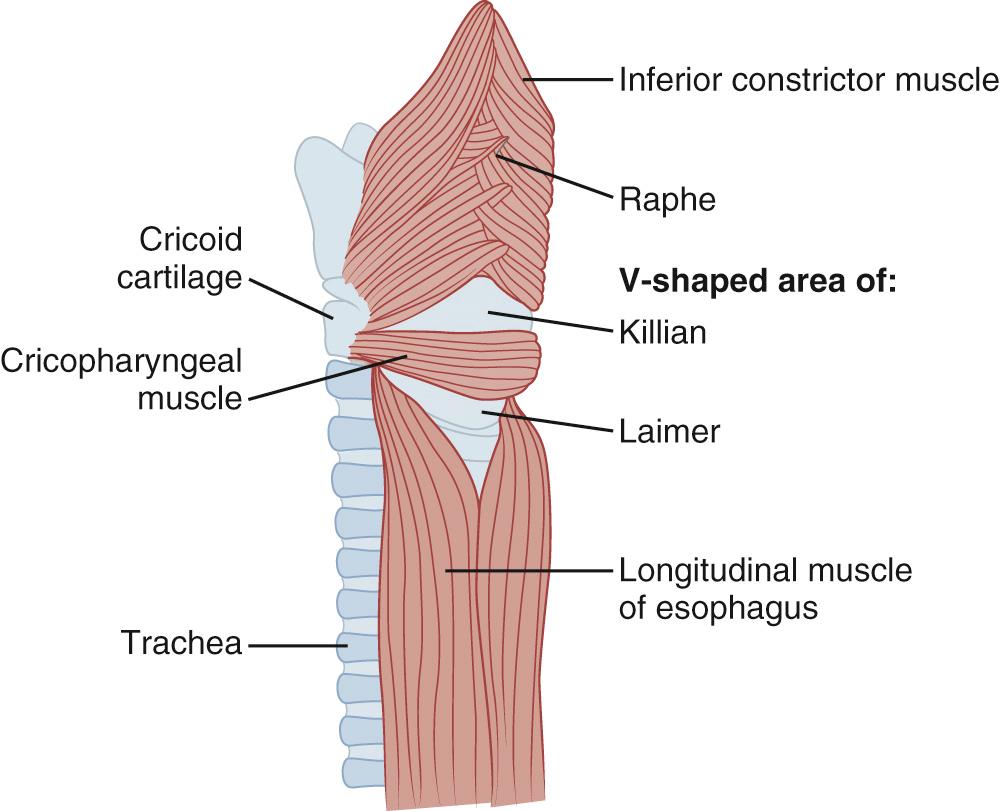
The thoracic portion of the esophagus is approximately 18 to 20 cm long (see Fig. 34-1 ) and starts at the thoracic inlet. In the upper portion of the thorax, it is closely related to the posterior membranous wall of the trachea. This close relationship is responsible for the early spread of cancer of the upper esophagus into the trachea, and it may limit the surgeon's ability to resect such a tumor. Above the level of the tracheal bifurcation, the esophagus courses to the right of the aortic arch and the descending aorta and then deviates to the left, passing behind the tracheal bifurcation and the left main bronchus. In the lower portion of the thorax, the esophagus remains deviated to the left and passes anteriorly through the diaphragmatic hiatus. There are three natural areas of constriction in the thoracic esophagus: the cricopharyngeus, or UES; the bronchoaortic constriction as it crosses behind the aortic arch and left mainstem bronchus; and the LES.
Unlike the remainder of the gastrointestinal tract, the esophagus does not have a serosal layer and its strength is derived from its mucosa. The thoracic esophagus is covered only by parietal pleura, making this portion the weakest and the most common site of perforation in Boerhaave syndrome, usually on the left side where there is a lack of support from adjacent structures.
The azygos vein is closely related to the right of the esophagus as it ascends from the abdomen and then arches from its paraspinal position over the esophagus and the right main bronchus to enter the superior vena cava.
The thoracic duct ascends behind and to the right of the distal thoracic esophagus between the azygous vein and aorta. At approximately the level of T5, it passes alongside the aorta and ascends on the left side of the esophagus to enter behind the junction of the left internal jugular and subclavian veins. Because of the possibility of disrupting the thoracic duct during its course across the mediastinum during an esophagectomy, ligation of the duct is generally performed low in the chest where it comes through the aortic hiatus.
The abdominal portion of the esophagus is approximately 3 to 6 cm long and includes the abdominal portion of the LES. It begins where the esophagus passes through the diaphragmatic hiatus, and it is surrounded by the phrenoesophageal membrane, a fibroelastic ligament that arises from the subdiaphragmatic fascia as a continuation of the transversalis fascia lining the abdomen ( Fig. 34-3 ). The upper leaf of the membrane attaches in a circumferential fashion around the esophagus approximately 1 to 2 cm above the level of the hiatus. The lower leaf of the phrenoesophageal membrane blends with the serosa of the stomach, and its end is marked anteriorly by a prominent fat pad, which corresponds approximately with the gastroesophageal junction. The LES is a zone of high pressure 3 to 4 cm long at the lower end of the esophagus and does not correspond to any visible macroscopic anatomic landmark either on the external surface of the esophagus or in the endoscopic appearance of the mucosa. Its function is derived from the microscopic architecture of the muscle fibers. The esophageal hiatus is surrounded by the right and left crura, which together form a sling of diaphragmatic skeletal muscle around the esophagus that originates from tendinous bands attached to the anterolateral surface of the first lumbar vertebra ( Fig. 34-4 ). The relative contribution of the right and left crura to this sling is variable. Posterior to the esophagus, the crura are united by a tendinous arch, the median arcuate ligament, which lies just anterior to the aorta.
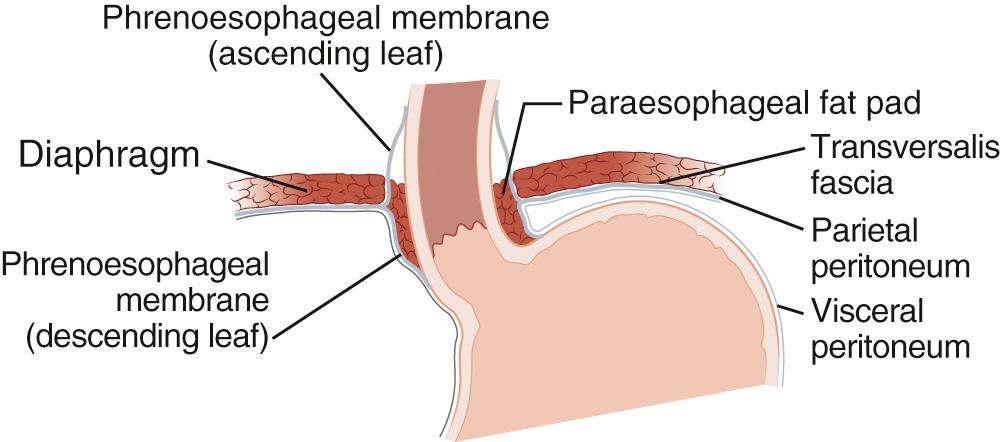
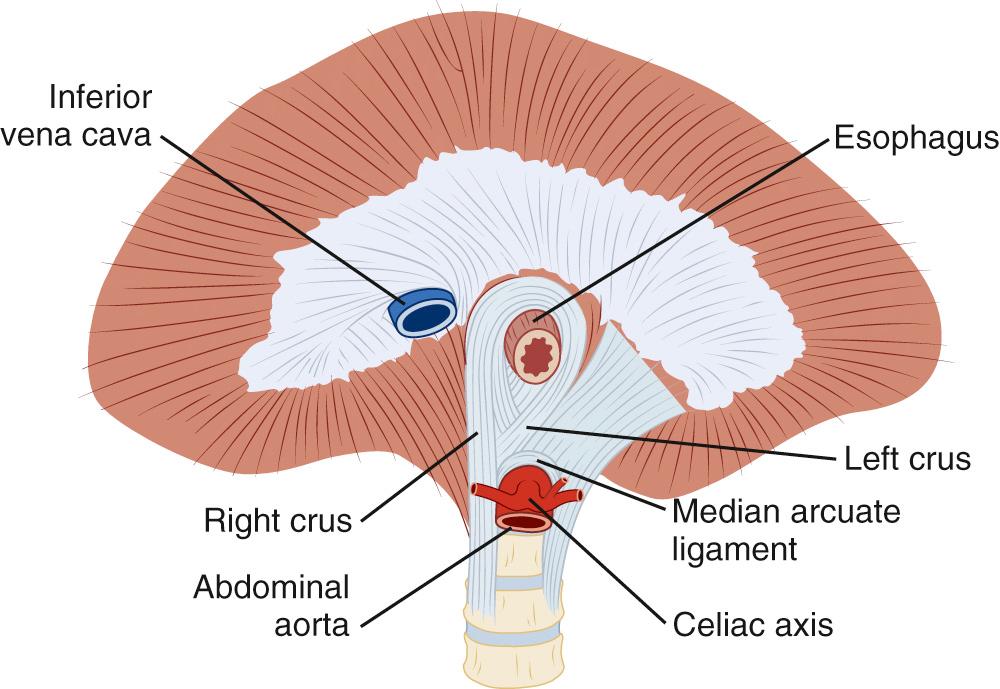
The esophagus is composed of three primary layers: mucosa, submucosa, and muscularis propria. The mucosal layer is normally made of nonkeratinized stratified squamous epithelium. In the distal aspect of the esophagus within the LES, repeated exposure of the squamous epithelium to gastric contents can result in metaplasia to a columnar epithelium known as cardiac mucosa. With further injury and exposure to a specific component of refluxed gastric juice such as bile acids, cardiac mucosa may transform into intestinal metaplasia or Barrett esophagus.
A critical layer within the mucosa for determining the biological behavior of superficial cancers is the muscularis mucosa. This thin, poorly developed layer lies below the basement membrane and above the submucosa. Early tumors that are restricted to the muscularis mucosa are usually confined to the mucosal layer and have little risk of gaining entry into the lymphatics for metastatic spread. When intestinal metaplasia does occur, it is common that the muscularis mucosa is splintered into two separate layers, which can complicate determining the depth of invasion of a superficial tumor.
The submucosa is characterized by a rich lymphatic plexus that extends throughout the esophagus. Lymphatic collecting branches arise from within the submucosa and pierce the muscularis propria to communicate with regional lymph nodes and the thoracic duct outside of the esophagus. This network of lymphatics allows for significant longitudinal spread of esophageal cancers and a high rate of skip metastases. Clinically, tumor invasion beyond the muscularis mucosa into the submucosa is significant as a result of this lymphatic system, with the rate of regional lymph node metastases increasing from less than 5% with intramucosal tumors up to approximately 50% for submucosal tumors. Finally, the submucosa of the esophagus also harbors mucous glands that drain into the lumen. These glands are helpful for determining the true extent of the esophagus when metaplasia of the mucosa occurs.
The muscularis propria has an inner circular layer and an outer longitudinal layer. The muscles are striated in the upper portion and transition to completely smooth muscle near the upper third of the esophagus. The longitudinal muscle layer courses down in an elongated spiral pattern, turning approximately 90 degrees as it descends to the stomach. The circular muscle layer is thicker than the longitudinal layer, which also takes on an elliptical or spiral orientation. This arrangement of muscle is responsible for the wormlike drive of peristalsis.
The cervical portion of the esophagus receives its main blood supply from the inferior thyroid artery. The thoracic portion receives blood from the bronchial and esophageal arteries. Seventy-five percent of individuals have one right-sided and two left-sided bronchial arteries, and usually two esophageal branches arise directly from the aorta. The blood supply of the abdominal portion of the esophagus comes from the ascending branch of the left gastric artery and from the right and left inferior phrenic arteries ( Fig. 34-5 ). After the vessels have entered the muscular wall of the esophagus, branching occurs at right angles to provide an extensive longitudinal vascular plexus. The rich blood supply provided by this vascular plexus allows mobilization of the esophagus from the stomach to the aortic arch without causing ischemic injury.
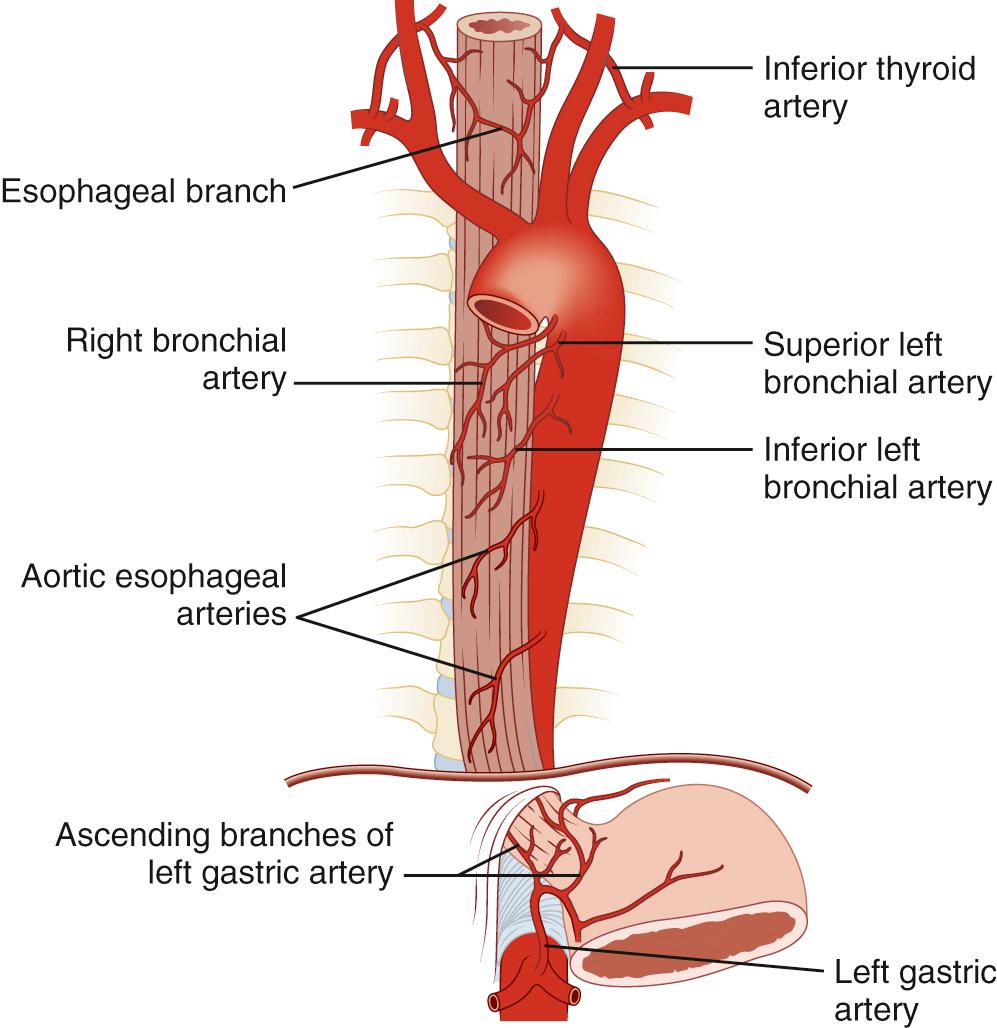
The capillaries of the esophagus drain into a submucosal and periesophageal venous plexus, from which the esophageal veins originate. In the cervical region, the esophageal veins empty into the inferior thyroid vein; in the thoracic region, they empty into the bronchial, azygos, or hemiazygos veins; and in the abdominal region, they empty into the coronary vein ( Fig. 34-6 ).
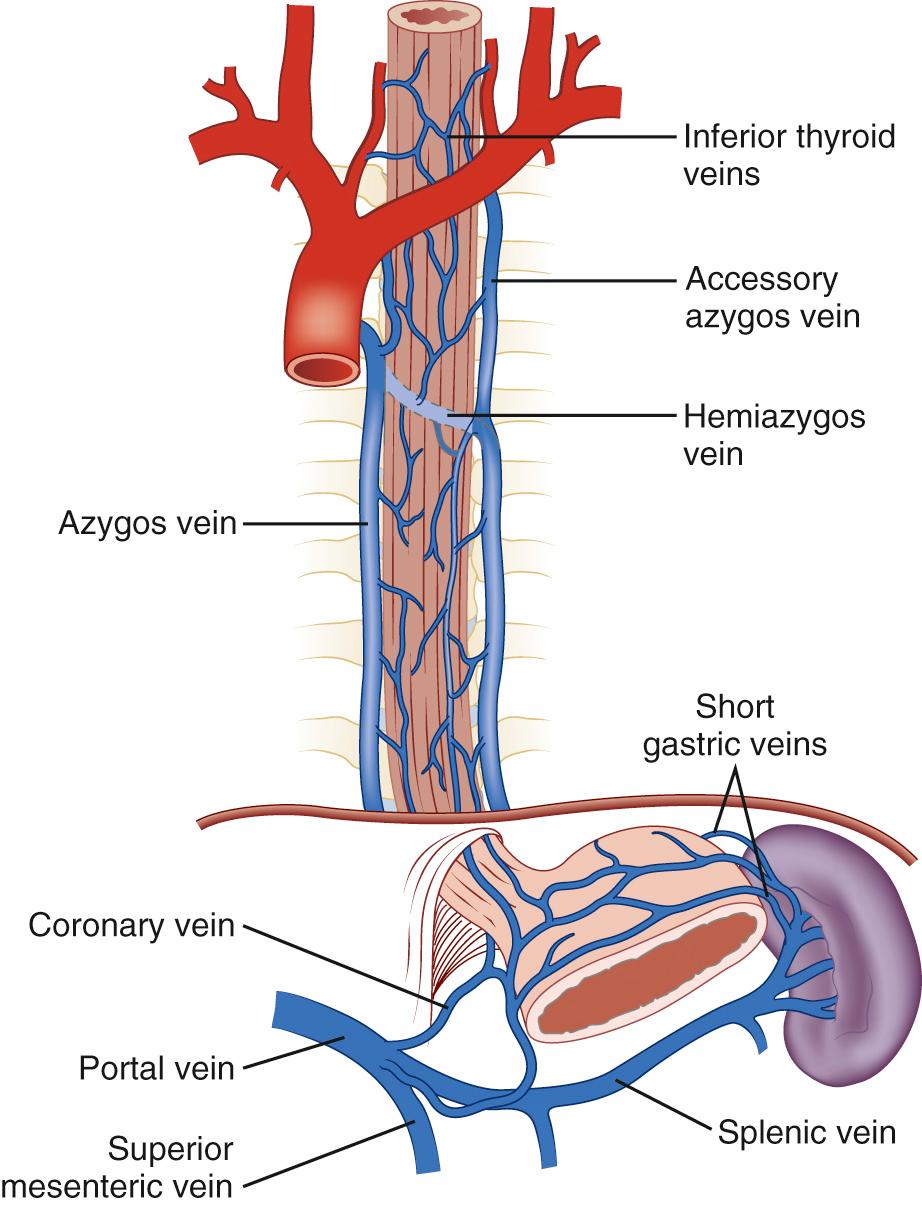
The lymphatic channels are located almost exclusively below the muscularis mucosa in the submucosa of the esophagus, constituting a dense and interconnected plexus with more lymph vessels than blood capillaries ( Fig. 34-7 ). Lymph flow in the submucosal plexus runs in a longitudinal direction, and after the injection of a contrast medium, the longitudinal spread is six times that of the transverse spread. In the upper two thirds of the esophagus, the lymphatic flow is mostly cephalad; in the lower third, it is mostly caudad. In the thoracic portion of the esophagus, the submucosal lymph plexus extends over a long distance in a longitudinal direction before penetrating the muscle layer to enter lymph vessels in the adventitia. As a consequence of this nonsegmental lymph drainage, the lymphatic spread of tumor cells can extend for a considerable distance superiorly and inferiorly within the submucosal lymphatics before the cells pass through lymphatic channels in the muscularis and into the regional lymph nodes. There is a high rate of skip metastases in esophageal cancer because of this arrangement. By contrast, the cervical esophagus has a more segmental lymph drainage into the regional lymph nodes, and as a result, tumors in this portion of the esophagus have less submucosal extension.
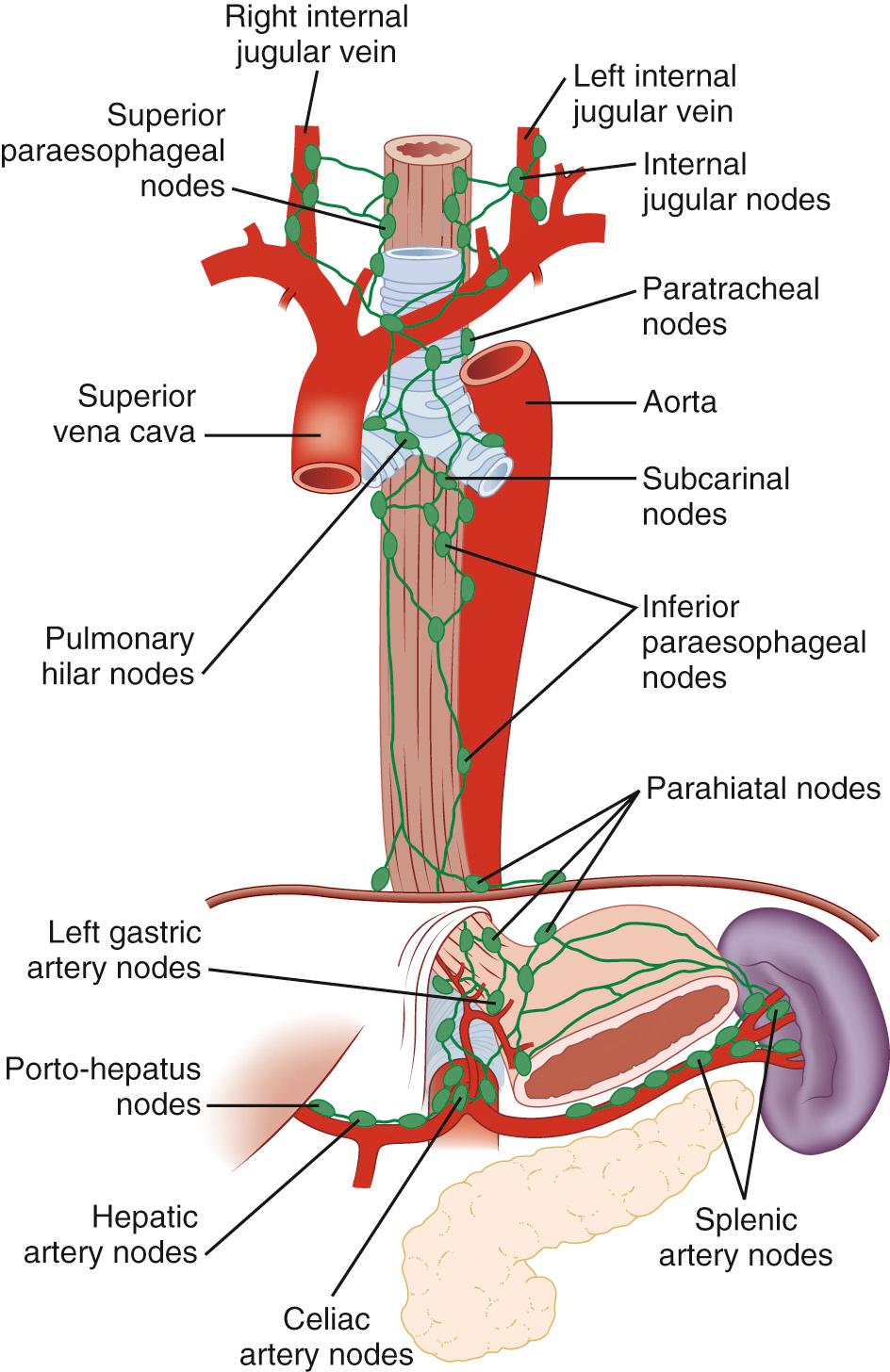
Lymph from the cervical esophagus drains into the paratracheal and deep cervical lymph nodes, whereas lymph from the upper thoracic esophagus flows mainly into the paratracheal lymph nodes. The lymph from the lower thoracic esophagus drains into the subcarinal and inferior pulmonary nodes. Lymph from the distal thoracic and abdominal portion of the esophagus drains into the parahiatal and perigastric nodes.
The parasympathetic innervation of the pharynx and esophagus is provided mainly by cranial nerve X or the vagus nerves. The constrictor muscles of the pharynx receive branches from the pharyngeal plexus, which is located on the posterior lateral surface of the middle constrictor muscle and is formed by pharyngeal branches of the vagus nerve, with a small contribution from cranial nerves IX and XI. The cricopharyngeal sphincter and the cervical portion of the esophagus receive branches from both right and left recurrent laryngeal nerves originating from the vagus nerves ( Fig. 34-8 ). Damage to these recurrent nerves interferes not only with the movement of the vocal cords but also with the function of the cricopharyngeal sphincter and the motility of the cervical esophagus, predisposing the patient to pulmonary aspiration on swallowing. The upper thoracic esophagus receives innervation from the left recurrent laryngeal nerve and both vagus nerves. As the right and left vagus nerves descend into the mediastinum, they join the outer surface of the esophagus. The esophageal plexus, which is formed by the branches of the right and left vagus nerves and thoracic sympathetic chain, lies on the anterior and posterior walls of the esophagus and innervates the lower thoracic portion. The branches of the plexus coalesce into the left (anterior) and right (posterior) vagal trunks.
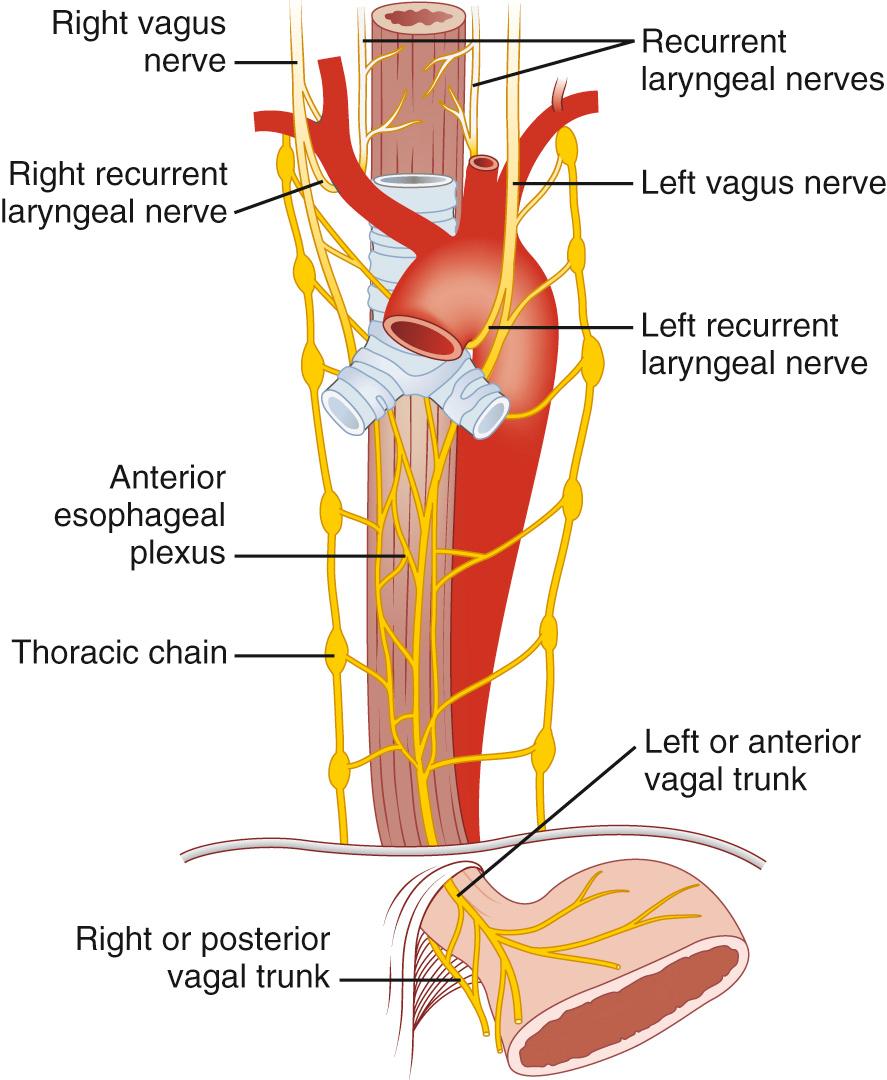
Afferent visceral sensory fibers from the esophagus end without synapse in the first four segments of the thoracic spinal cord by a combination of sympathetic and vagal pathways. These pathways are also occupied by afferent visceral sensory fibers from the heart, which explains the similarity of symptoms in esophageal and cardiac diseases.
Become a Clinical Tree membership for Full access and enjoy Unlimited articles
If you are a member. Log in here